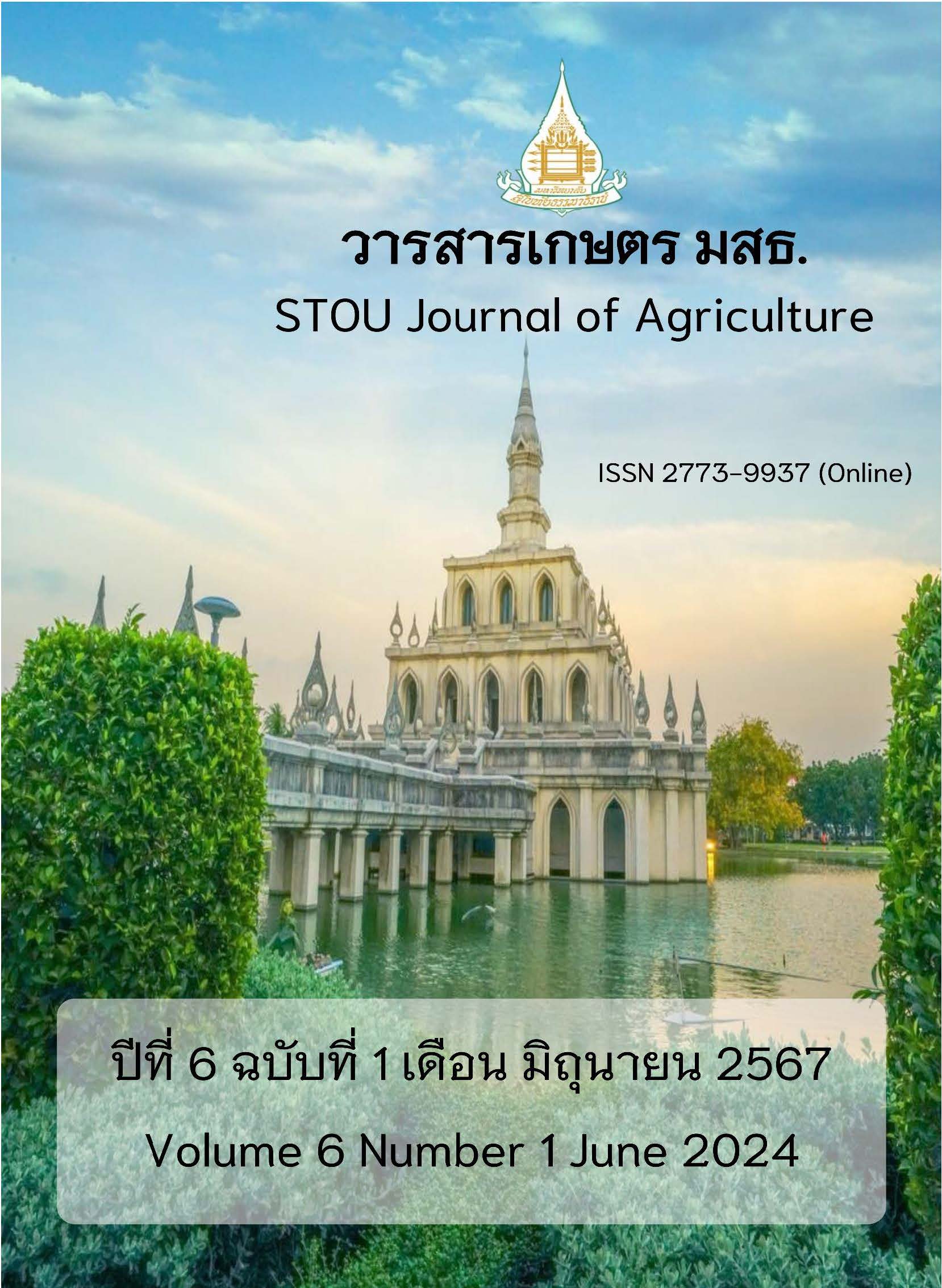แนวทางการดำเนินงานการจัดการสินค้าเกษตรของศูนย์เทคโนโลยีการเกษตร คนพิการนานาชาติ ตำบลหนองปรือ อำเภอบางละมุง จังหวัดชลบุรี
Main Article Content
บทคัดย่อ
การศึกษานี้มีวัตถุประสงค์เพื่อศึกษา 1) การดำเนินงานการจัดการสินค้าเกษตรของศูนย์เทคโนโลยีการเกษตรคนพิการนานาชาติ 2) ความต้องการของผู้บริโภคในการซื้อสินค้าเกษตรของศูนย์เทคโนโลยีการเกษตรคนพิการนานาชาติ และ 3) แนวทางการพัฒนากลยุทธ์ส่วนประสมการตลาดของสินค้าเกษตรของศูนย์เทคโนโลยีการเกษตรคนพิการนานาชาติ การศึกษาครั้งนี้เป็นการศึกษาแบบผสมวิธี ประกอบด้วย การวิจัยเชิงคุณภาพโดยการสัมภาษณ์เชิงลึกผู้บริหารและเจ้าหน้าที่ของศูนย์เทคโนโลยีการเกษตรคนพิการนานาชาติ จำนวน 5 ราย และการวิจัยเชิงปริมาณ ประชากรที่ศึกษา คือ ผู้บริโภคสินค้าเกษตรตามบัญชีรายชื่อลูกค้าของศูนย์เทคโนโลยีการเกษตรคนพิการนานาชาติ จำนวน 550 ราย โดยใช้แบบสอบถามกับกลุ่มตัวอย่างผู้บริโภคสินค้าของศูนย์เทคโนโลยีการเกษตรคนพิการนานาชาติ จำนวน 60 ราย เลือกแบบเจาะจง สถิติที่ใช้ในการวิเคราะห์ข้อมูลเชิงปริมาณ ได้แก่ ค่าความถี่ ค่าร้อยละ ค่าเฉลี่ย และส่วนเบี่ยงเบนมาตรฐาน และการวิเคราะห์ข้อมูลเชิงคุณภาพใช้การวิเคราะห์เนื้อหา
ผลการศึกษาพบว่า 1) การดำเนินงานการจัดการสินค้าเกษตร พบว่า มีการมอบหมายให้คนพิการ
ทำการปลูกผักร่วมกับเจ้าหน้าที่ซึ่งทำหน้าที่เป็นพี่เลี้ยงคอยดูแลตลอดกระบวนการผลิต ภายหลังการเก็บเกี่ยวผลผลิตทั้งหมดจะถูกบรรจุและวางจำหน่ายด้านหน้าศูนย์ฯ มีการติดสติ๊กเกอร์สโลแกนของศูนย์ เพื่อแสดงถึงที่มาของผลผลิต โดยกำหนดราคาสินค้าตามราคาตลาด สำหรับการจัดจำหน่ายมี 2 ช่องทาง ทั้งแบบออนไลน์ ได้แก่ กลุ่มไลน์ของบริษัทเอกชน กลุ่มของผู้พิการที่เข้าอบรม และแบบออฟไลน์ ได้แก่ หน้าศูนย์ฯ 2) ความต้องการของผู้บริโภคในการซื้อสินค้าเกษตร พบว่า กลุ่มตัวอย่างส่วนใหญ่มีความต้องการซื้อสินค้าเกษตรเฉลี่ยในภาพรวมอยู่ในระดับมาก จำแนกเป็นรายด้านกลุ่มตัวอย่างให้ความสำคัญอยู่ในระดับมากที่สุด ได้แก่ การมีช่องทางการชำระเงิน ทั้งเงินสดและแสกนผ่านแอพพลิเคชั่น ในระดับมาก ได้แก่ การได้รับการดูแลเอาใจใส่จากพนักงานขาย ผลผลิตมีความน่าเชื่อถือ และราคาของผักที่จำหน่ายมีความเหมาะสมกับคุณภาพ 3) แนวทางการพัฒนากลยุทธ์ส่วนประสมการตลาด ประกอบด้วย ด้านผลิตภัณฑ์ ควรจัดหาตู้แช่ผลผลิตเพื่อยืดอายุผลผลิต และเร่งดำเนินการขอการรับรองมาตรฐานเกษตรอินทรีย์ ด้านราคา ควรใช้กลยุทธ์การกำหนดราคาเหนือคู่แข่งขัน ด้านการจัดจำหน่าย ควรเพิ่มช่องทางการจำหน่ายโดยการขยายร้านสาขา และด้านการส่งเสริมการตลาด ควรใช้กลยุทธ์การส่งเสริมการตลาดตามสถานการณ์/เทศกาล โดยใช้การประชาสัมพันธ์แบบมวลชนร่วมกับเครือข่ายพันธมิตรองค์กร
Article Details

อนุญาตภายใต้เงื่อนไข Creative Commons Attribution-NonCommercial-NoDerivatives 4.0 International License.
บทความที่ได้รับการตีพิมพ์เป็นลิขสิทธฺ์ของวารสารเกษตร มสธ.
ข้อความที่ปรากฎใน
เอกสารอ้างอิง
กชวรรณ เวชชพิทักษ์. (2562). กลยุทธ์การตลาด 5A และการตัดสินใจซื้อสินค้าเกษตรอินทรีย์ของผู้บริโภค. วิทยานิพนธ์บริหารธุรกิจมหาบัณฑิต, มหาวิทยาลัยศิลปากร.
กรมส่งเสริมและพัฒนาคุณภาพชีวิตคนพิการ. (2565). รายงานข้อมูลสถานการณ์ด้านคนพิการในประเทศไทย. สืบค้นเมื่อ 24 พฤษภาคม 2566, จาก http://dep.go.th/images/uploads/Downloads/pdf.
ชนนิกานต์ จงไกรจักร. (2561). ส่วนประสมทางการตลาด คุณค่าตราสินค้า และทัศนคติที่ส่งผลต่อการตัดสินใจซื้อสินค้าผักปลอดสารพิษของผู้บริโภคในกรุงเทพมหานคร. บริหารธุรกิจมหาบัณฑิต มหาวิทยาลัยกรุงเทพ.
ณัฐวุฒิ จั่นทอง อัณธิกา เสงี่ยมใจ และพหล ศักดิ์คะทัศน์. (2565). การยอมรับเทคโนโลยีการผลิตกล้วยหอมตามการปฏิบัติทางการเกษตรที่ดีและเหมาะสม (GAP) ของเกษตรกรในเขตภาคกลางตอนบน.วารสารวิจัยและส่งเสริมวิชาการเกษตร, 40 (1), 150-160.
เธียรชัย พันธ์คง และปริยากร บุญส่ง. (2565). แนวทางกลยุทธ์ส่วนประสมทางการตลาดข้าวอินทรีย์ของเกษตรกรในอำเภอระโนด จังหวัดสงขลา.การประชุมหาดใหญ่วิชาการ ระดับชาติและนานาชาติครั้งที่ 13, 3287-3298.
นัทธ์หทัย เถาตระกูล และภัทรพรรณ วรรณลักษณ์. (2565). การพัฒนาการตลาดสินค้าเกษตรของชุมชน จังหวัดเชียงใหม่ให้มีความสามารถในการแข่งขันระดับประเทศอาเซียน. วารสารราชภัฏเพชรบูรณ์สาร, 24 (1), 25-33.
นิตยา วงศ์ยศ. (2564).ปัจจัยที่มีผลต่อการตัดสินใจซื้อผักปลอดสารพิษของผู้บริโภคในตลาดเกษตร จังหวัดพะเยา.วารสารมนุษยศาสตร์และสังคมศาสตร์ มหาวิทยาลัยเอเชียอาคเนย์, 3(1), 133-145.
พรสวรรค์ เพชรรัตน์ อรุณี ม่วงแก้วงาม วิไลวัลย์ แก้วตาทิพย์ สมทบ เวทโอสถ และนิราณี บือราเฮง. (2565). การผลิตผักปลอดสารพิษในอําเภอแม่ลาน จังหวัดปัตตานี. วารสารวิทยาศาสตร์และเทคโนโลยี มรย. ปีที่ 7 ฉบับที่ 3 กันยายน-ธันวาคม 2565. หน้า 28-36.
มาริสา ชนมานะวัตร. (2562). ปัจจัยที่มีผลต่อการตัดสินใจเลือกซื้อผักและผลไม้สดของผู้บริโภคในระบบสายโซ่ความเย็น (Cold Chain) จากร้านค้าปลีกสมัยใหม่.สารนิพนธ์.ปริญญาการจัดการมหาบัณฑิต วิทยาลัยการจัดการ มหาวิทยาลัยมหิดล.
ศศิโสม สิงห์คนอง. (2561). กระบวนการตัดสินใจซื้อผักปลอดสารในเขตกรุงเทพมหานคร. การค้นคว้าอิสระ.บริหารธุรกิจมหาบัณฑิต คณะบริหารธุรกิจ มหาวิทยาลัยรามคำแหง.
ศูนย์เทคโนโลยีการเกษตรคนพิการนานาชาติ. (2565). ศูนย์เทคโนโลยีการเกษตรคนพิการ - 20raiorganicfarm. สืบค้นเมื่อ 24 พฤษภาคม 2566, จาก
https://www.facebook.com/watch/?v=605441014450005
สุริยนต์ สูงคำ และลัดดำ ปินตำ. (2565). การจัดการห่วงโซ่อุปทานสินค้าเกษตรปลอดภัยของ บริษัท เชียงใหม่วิสาหกิจเพื่อสังคมจำกัด.วารสารบริหารธุรกิจและศิลปศาสตร์ราชมงคลล้านนา,10(2), 1-18.


